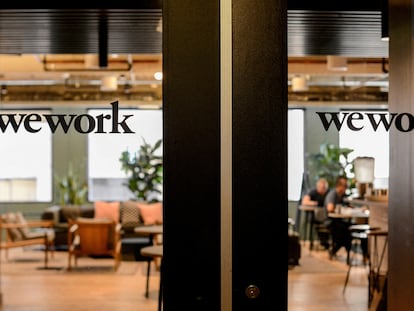WeWork seeks bankruptcy protection in stunning fall for a firm once valued at close to $50 billion
The company is paying the price for aggressive expansion in its early years. It entered into a restructuring support agreement with the majority of its stakeholders to ‘drastically reduce’ its debt

WeWork has filed for Chapter 11 bankruptcy protection, marking a stunning fall for the office sharing company once seen as a Wall Street darling that promised to upend the way people went to work around the world. In a late Monday announcement, WeWork said it entered into a restructuring support agreement with the majority of its stakeholders to “drastically reduce” the company’s debt while further evaluating WeWork’s commercial office lease portfolio.
WeWork is also requesting the “ability to reject the leases of certain locations,” which the company says are largely non-operational, as part of the filing. Specific estimates of total impacted locations were not disclosed Monday, but all affected members have received advanced notice, the company said.
“Now is the time for us to pull the future forward by aggressively addressing our legacy leases and dramatically improving our balance sheet,” CEO David Tolley said in a prepared statement. “We defined a new category of working, and these steps will enable us to remain the global leader in flexible work.”
The specter of bankruptcy has hovered over WeWork for some time. In August, the New York company sounded the alarm over its ability to remain in business. But cracks had begun to emerge several years ago, not long after the company was valued as high as $47 billion.
WeWork is paying the price for aggressive expansion in its early years. The company went public in October 2021 after its first attempt to do so two years earlier collapsed spectacularly. The debacle led to the ouster of founder and CEO Adam Neumann, whose erratic behavior and exorbitant spending spooked early investors. Japan’s SoftBank stepped in to keep WeWork afloat, acquiring majority control over the company.
In a prepared statement Monday ahead of WeWork’s official announcement, Neumann called the bankruptcy filing disappointing and said it’s been challenging for him “to watch from the sidelines since 2019 as WeWork has failed to take advantage of a product that is more relevant today than ever before.” Still, he added, a strong reorganization could allow WeWork to emerge successfully.
Despite efforts to turn the company around since Neumann’s departure — including significant cuts to operating costs and rising revenue — WeWork has struggled in a commercial real estate market that has been rocked by the rising cost of borrowing money, as well as a shifting dynamic for millions of office workers now checking into their offices remotely. In Monday’s filing, WeWork listed about $18.7 million in debts and $15.1 million in assets as of June 30.
In September, when WeWork announced plans to renegotiate nearly all of its leases, Tolley noted that the company’s lease liabilities accounted for more than two-thirds of its operating expenses for the second quarter of this year — remaining “too high” and “dramatically out of step with current market conditions.”
At the time, WeWork also said it could exit more underperforming locations. As of June 30, the latest date with property numbers disclosed in securities filings, WeWork had 777 locations in 39 countries.
Beyond real estate costs, WeWork has pointed to increased member churn and other financial losses. In August, the company said that its ability to stay in operation was contingent upon improving its liquidity and profitability overall in the next year.
WeWork’s bankruptcy filing arrives at a time when leasing demand for office space is weak overall. The COVID-19 pandemic notably led to rising vacancies in office space as working from home became increasingly popular — and major U.S. markets, from New York to San Francisco, are still struggling to recover.
In the U.S., experts note that WeWork’s 18 million square feet is a small fraction of total office inventory in the country — but on a building-by-building level, landlords with exposure to WeWork could take significant hits if their leases are terminated. The shuttering of select WeWork locations to cut costs isn’t new. In some past cases, landlords’ building loans moved to special servicing after losing WeWork as a tenant, credit rating and research firm Morningstar Credit previously told The Associated Press.
While the full impact of this week’s bankruptcy filing on WeWork’s real estate footprint is still uncertain, the company sounded an optimistic note Monday night.
“Our spaces are open and there will be no change to the way we operate,” a WeWork spokesperson said in a statement to The Associated Press. “We plan to stay in the vast majority of markets as we move into the future and remain committed to delivering an exceptional experience and innovative flexible workspace solutions for our members.”
WeWork and certain entities filed for Chapter 11 bankruptcy protection in U.S. District Court in New Jersey, with plans to also file recognition proceedings in Canada, according to Monday’s announcement.
WeWork locations outside of the U.S. and Canada will not be affected by the proceedings, the company said, as well as franchisees worldwide.
Sign up for our weekly newsletter to get more English-language news coverage from EL PAÍS USA Edition
Tu suscripción se está usando en otro dispositivo
¿Quieres añadir otro usuario a tu suscripción?
Si continúas leyendo en este dispositivo, no se podrá leer en el otro.
FlechaTu suscripción se está usando en otro dispositivo y solo puedes acceder a EL PAÍS desde un dispositivo a la vez.
Si quieres compartir tu cuenta, cambia tu suscripción a la modalidad Premium, así podrás añadir otro usuario. Cada uno accederá con su propia cuenta de email, lo que os permitirá personalizar vuestra experiencia en EL PAÍS.
¿Tienes una suscripción de empresa? Accede aquí para contratar más cuentas.
En el caso de no saber quién está usando tu cuenta, te recomendamos cambiar tu contraseña aquí.
Si decides continuar compartiendo tu cuenta, este mensaje se mostrará en tu dispositivo y en el de la otra persona que está usando tu cuenta de forma indefinida, afectando a tu experiencia de lectura. Puedes consultar aquí los términos y condiciones de la suscripción digital.
More information
Archived In
Últimas noticias
Most viewed
- Sinaloa Cartel war is taking its toll on Los Chapitos
- Oona Chaplin: ‘I told James Cameron that I was living in a treehouse and starting a permaculture project with a friend’
- Reinhard Genzel, Nobel laureate in physics: ‘One-minute videos will never give you the truth’
- Why the price of coffee has skyrocketed: from Brazilian plantations to specialty coffee houses
- Silver prices are going crazy: This is what’s fueling the rally










































